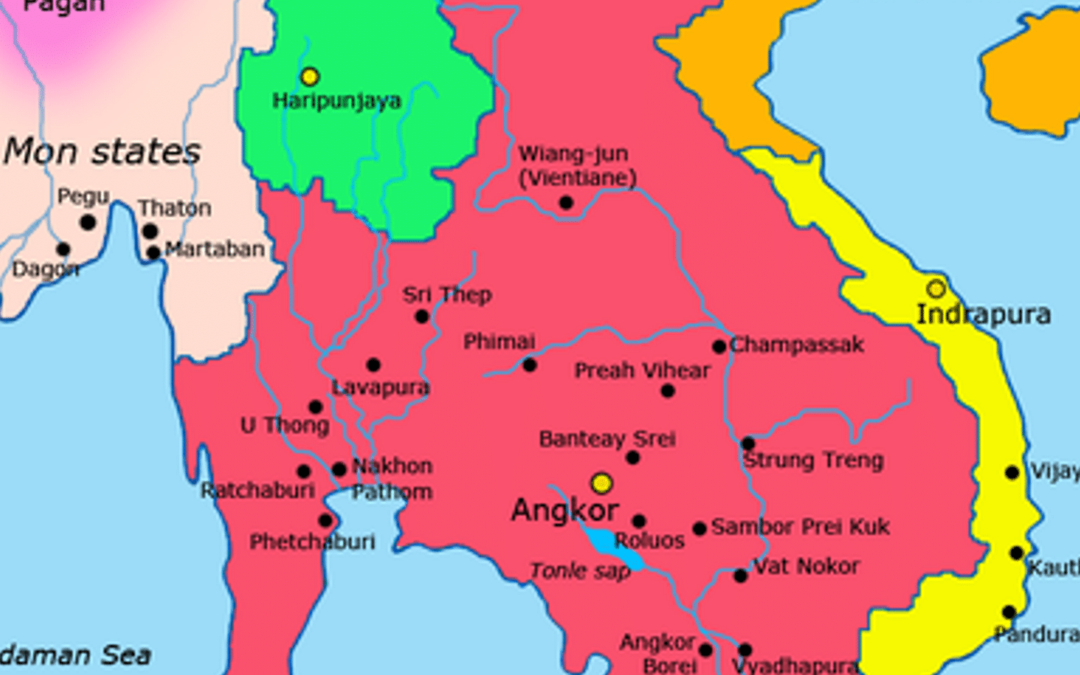The mighty Khmer Empire's fall wasn't due to just one thing – it was hit with everything at once! You're looking at devastating military defeats from Thai kingdoms, extreme climate swings that wrecked their incredible water systems, and a major religious shift from Hindu-Buddhism to Theravada Buddhism that shook up their whole society. Plus, they faced brutal economic decline, constant political fighting, and the loss of their maritime trade routes. The deeper you investigate, the more fascinating layers of this empire's collapse emerge.
Key Takeaways
- Military invasions from Thai kingdoms and Cham forces weakened the empire, culminating in Ayutthaya's capture of Angkor in 1431.
- Severe climate fluctuations between droughts and intense monsoons destroyed Angkor's vital water management infrastructure and agriculture.
- The shift to Theravada Buddhism eroded traditional power structures and reduced royal authority based on divine kingship.
- Economic decline resulted from failing agricultural systems, neglected maritime trade, and the shift of commerce away from Angkor.
- Internal political instability and frequent leadership changes prevented effective responses to external threats and infrastructure problems.
Military Defeats and External Threats
While the Khmer Empire stood as one of Southeast Asia's most powerful kingdoms for centuries, its dramatic fall began with a devastating blow in 1177.
That's when Cham forces launched a surprise attack on the capital of Yasodharapura, killing the king and occupying the city for four years! Though Jayavarman VII's military strategy later pushed back the Chams, the empire's territorial expansion days were numbered.
You wouldn't believe how quickly things unraveled after that.
The Thai kingdoms of Sukhothai and Ayutthaya started chipping away at Khmer territories, while Lan Xang raiders struck from the north. It was like watching dominoes fall – one defeat after another until the final blow came in 1431.
That's when Ayutthaya captured Angkor, forcing the Khmer to abandon their magnificent capital and retreat to Phnom Penh.
Environmental Changes and Climate Impact
After centuries of military dominance, you'd never guess that nature itself would deal one of the deadliest blows to the mighty Khmer Empire.
What brought this powerful civilization to its knees? The answer lies in the perfect storm of environmental challenges!
You see, Angkor's sophisticated water management system couldn't handle the extreme climate variability that hit the region.
Decades-long droughts alternated with intense monsoons, wreaking havoc on their carefully engineered canals and reservoirs.
Nature's cruel cycle of drought and deluge proved too much for even the Khmer Empire's masterful water engineering.
The drought impact was devastating – imagine watching your farmland turn to dust while your complex irrigation system falls apart!
Tree ring evidence from Vietnam tells the story: El Niño events triggered massive climate swings that the empire just couldn't adapt to.
Even their impressive barays (reservoirs) couldn't save them when nature decided to turn up the heat.
Religious Transformation and Cultural Shifts
Beneath the grand temples of Angkor, a religious revolution was quietly transforming the mighty Khmer Empire from its very core. You'd hardly recognize the empire after its dramatic religious conversion from Brahmano-Buddhist traditions to Theravada Buddhism – a shift that turned the kingdom's social hierarchy upside down!
This wasn't just about switching religions; it was a complete cultural integration that changed everything. Those magnificent temples you've heard about? They were repurposed for new Buddhist worship, and the kings – who once ruled as living gods – found their divine authority crumbling.
Meanwhile, the rising Tai kingdoms were enthusiastically absorbing Khmer culture while simultaneously threatening the empire's borders. Traditional practices you'd associate with ancient Angkor, like cosmic renewal ceremonies, gave way to simpler, more egalitarian Buddhist customs.
Economic Decline and Trade Disruption
As the mighty Khmer Empire entered its final chapter, you'd find its once-thriving economy crumbling under the weight of multiple pressures.
Watch as one of history's mightiest empires stumbles and falls, its economic foundations buckling beneath mounting challenges.
The empire's stubborn focus on domestic economy, while ignoring international maritime trade, proved to be a costly mistake. You can imagine the frustration as agricultural productivity plummeted due to severe droughts and floods that wreaked havoc on their sophisticated water systems!
Talk about a perfect storm – while their neighbors were getting rich through maritime trade, the Khmer's problems kept piling up.
Their precious water management system started failing, forests were cleared for more rice fields (bad move!), and trade centers shifted from Angkor to Phnom Penh.
It's like watching a mighty ship sink because of too many holes in its hull.
Political Instability and Power Struggles
While the Khmer Empire's economy was falling apart, its political foundation was crumbling even faster! Internal fractures within the empire led to constant power struggles that weakened royal authority.
You wouldn't believe how quickly things fell apart – the empire's leadership changed hands so frequently that nobody could maintain stable control!
The situation became even more chaotic with these major problems:
- The shift to Theravada Buddhism challenged the traditional class system
- Rival kingdoms like Sukhothai and Ayutthaya kept invading Khmer territory
- Internal power struggles made it impossible to defend against external threats
If you've ever seen a house of cards collapse, that's exactly what happened to the Khmer Empire's political structure.
Infrastructure Collapse and Water Management
The mighty Khmer Empire didn't just crack under political pressure – its impressive water infrastructure literally crumbled beneath its feet!
You've got to understand the massive scale of their water management failure. At Koh Ker, their reservoir collapsed during its initial rainy season due to poor design, forcing the embarrassed King Jayavarman IV to relocate the capital.
But that's not all! In Angkor, where nearly a million people lived, the extensive canal system couldn't handle the perfect storm of challenges.
Initially, deforestation led to increased sedimentation. Then, mother nature delivered a brutal one-two punch: prolonged drought followed by intense monsoons.
The canals, already choked with mud and debris, simply couldn't cope. When you combine these ecological challenges with an overtaxed system, you're looking at a recipe for disaster!
Social Changes and Population Migration
Beneath the crumbling infrastructure of the Khmer Empire lay an even more fascinating story of social upheaval and mass exodus!
As you'll uncover, the traditional social hierarchy was shaken to its core when Theravada Buddhism swept through the empire, challenging the divine authority of kings and promoting equality.
This spiritual revolution, combined with mounting external pressures, triggered dramatic migration patterns that would forever change the empire's demographic landscape.
Here's what pushed people to abandon their homes:
- Repeated attacks from Thai kingdoms made city life increasingly dangerous
- Climate change wreaked havoc on agricultural productivity
- The shift to Buddhism reduced the workforce needed for temple maintenance
You can imagine the chaos as entire communities fled to safer regions, while those who stayed witnessed their once-mighty empire's social fabric unravel before their eyes!
The transformation was unstoppable.
Legacy of the Khmer Empire's Decline
Looking beyond the mass exodus and social upheaval, you'll find that the lasting imprint of the Khmer Empire's decline runs remarkably deep! The empire's cultural heritage lives on through Angkor's awe-inspiring temples – structures that used MORE stone than Egypt's pyramids!
| Impact Area | Legacy Effects |
|---|---|
| Economics | Trade routes collapsed, regional commerce disrupted |
| Environment | Water systems failed, deforestation accelerated |
| Politics | Power struggles weakened central authority |
| Culture | Buddhist conversion transformed society |
You'll uncover archaeological significance in every corner of these ancient ruins. While political instability and environmental challenges ultimately brought the empire to its knees, its architectural achievements continue to inspire wonder. Today, you can trace the empire's final chapter through scattered remains, where ongoing research reveals new secrets about this remarkable civilization's decline.
Conclusion
You'll find that the mighty Khmer Empire's fall wasn't due to just one factor – it was a perfect storm! From devastating military defeats and extreme weather changes to crumbling infrastructure and religious upheaval, multiple forces brought down this powerful civilization. Today, you can still see the empire's lasting influence in Southeast Asia's art, architecture, and culture, even though Angkor's once-mighty temples now stand as silent reminders of its former glory.



